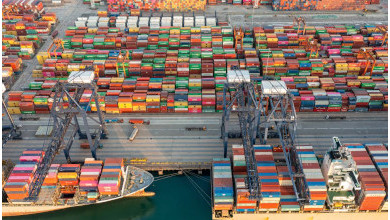Congress Clears New Rules on Ocean Container Ships

The Ocean Shipping Reform Act, which is supported by RV Industry Association, cleared Congress on Monday and is expected to be signed into law by President Joe Biden in the coming days.
The bill, which will be the first overhaul of ocean shipping rules since 1998, effectively turns the Federal Maritime Commission, which has oversight over the industry, from an agency that passively investigates complaints from shippers into one that can proactively police ocean carriers. These are the first major changes to be made to the ocean shipping industry in 25 years, marshaling a rare bipartisan legislative victory that was spurred by high container prices and complaints from American exporters frustrated that they can’t ship their goods abroad.
“Like many other industries, the RV industry has dealt with supply chain challenges in the wake of the COVID-19 pandemic,” said Samantha Rocci, senior manager of the RV Industry Association’s government affairs team. “The RV Industry Association supports the Ocean Shipping Reform Act and its potential to lower costs on American manufacturing. Although there’s no quick fix for the ongoing supply chain issues we face, our government affairs team is excited to see Congress and the Biden administration working to alleviate part of the strain on American businesses.”
The bill is intended to give the Federal Maritime Commission (FMC) additional teeth to oversee an ocean shipping industry that is dominated by a handful of large overseas companies, a situation that supporters of the bill say has created monopolistic practices that are driving prices sky high and locking out American exporters in favor of other, more lucrative cargo.
The legislative effort to pass the bill began about a year ago when Reps. John Garamendi and Dusty Johnson began hearing from agricultural producers in their districts that container shipping companies were refusing to take their goods, instead preferring to ship empty containers back to East Asia where they could be more quickly filled with more profitable exports to the U.S.
Ocean carriers opposed the bill, arguing that supply chain issues on land are the cause of ongoing issues with containers at ports.
The bill shifts the burden of proof for complaints from the shipper onto the ocean carriers and allows the FMC to initiate formal investigations on their own without waiting for a third party to issue a complaint. It also requires ocean carriers to prove that the shipper acted unreasonably when any detention and demurrage fees are placed on a shipper, a reversal of the current burden of proof that requires the shipper to show they did nothing wrong.
Detention and demurrage fees are charged when containers have not been picked up by the shipper or if a container is in use by a shipper for more than an agreed upon timeframe.
The bill also requires the FMC to initiate two rulemakings, one that defines unfair and unjust container shipping practices and another that defines the unreasonable refusal of goods on containers that are leaving U.S. ports. Within 30 days of the bill becoming law, the FMC must initiate a rule defining unreasonable refusal of goods and a final rule must be issued within six months. A rulemaking defining unjust and unfair container shipping practices must be initiated within 60 days, with a final rule coming within a year.
In addition, Congress has provided the FMC with more money to carry out oversight on the industry, though lawmakers also said the shifting of burdens onto ocean carriers means it will take fewer resources to investigate complaints.
The bill also requires the FMC to publish additional data on the container shipping market online, to give shippers an additional resource to determine if rates are unreasonably excessive. And while the bill would have effects at ports across the country, lawmakers and staffers acknowledged that the most egregious price fluctuations and most frequent use of detention and demurrage fees is at the ports of Los Angeles and Long Beach for goods traveling across the Pacific. Those two ports account for 31 percent of all U.S. trade that moves in containers through seaports.



